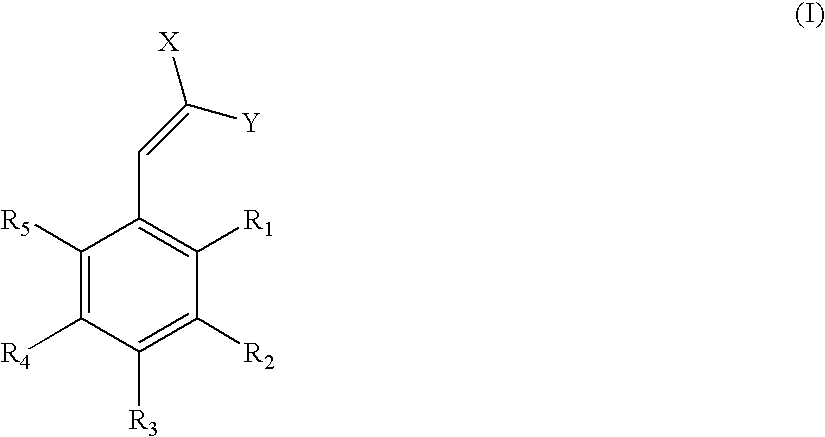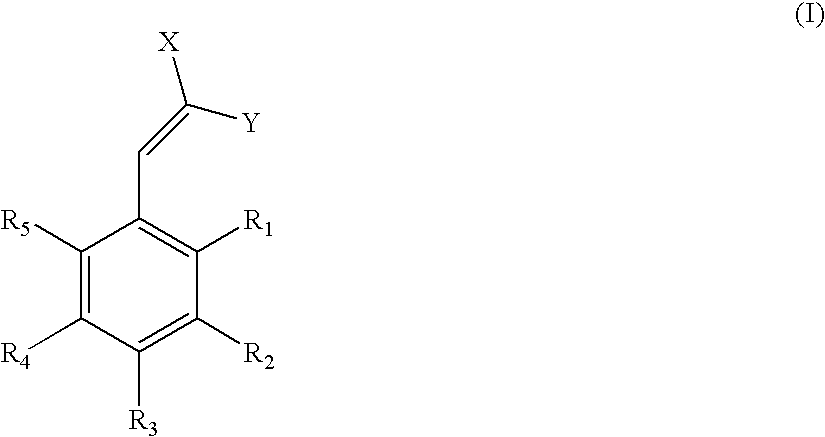Low-color ultraviolet absorbers for thermoplastic and thermoset high UV wavelength protection applications
a technology of ultraviolet absorbers and thermoplastics, applied in the direction of film/foil adhesives, medical preparations, inks, etc., can solve the problems of difficult incorporation within different target media, relatively low melting points, and potentially damaging the range of unprotected ultraviolet exposure, and achieve the effect of brighter clarity
- Summary
- Abstract
- Description
- Claims
- Application Information
AI Technical Summary
Benefits of technology
Problems solved by technology
Method used
Image
Examples
example 3
4-Hydroxybenzaldehyde 5EO / BCA UV Absorber
[0038] To a 250-ml 3-neck flask, were charged with 100 grams of 4-hydroxybenzaldehyde 5EO from Example 1, 44 grams of butyl cyanoacetate (BCA) and 8 grams of ammonium acetate. The reaction was allowed to heat to 50.degree. C. for 3 hours in the presence of a nitrogen atmosphere. Upon cooling to room temperature, 200 ml of water were added and the mixture heated to 75.degree. C. After phasing, the product layer was washed again with 200 ml of water. Removal of water via rotary evaporator yielded 117 g of product that has a lambda max of 341 nm in methanol and color value of 65 (abs / g / L).
example 4
4-Hydroxybenzaldehyde 5EO / EHCA UV Absorber
[0039] To a 250-ml 3-neck flask, were charged with 50 grams of 4-hydroxybenzaldehyde 5EO from Example 1, 30.5 grams of 2-ethylhexyl cyanoacetate (EHCA) and 4 grams of ammonium acetate. The reaction was allowed to heat to 50.degree. C. for 3 hours in the presence of a nitrogen atmosphere. Upon cooling to room temperature, 100 ml of water were added and the mixture heated to 75.degree. C. After phasing, the product layer was washed again with 100 ml of water. Removal of water via rotary evaporator yielded 59 g of product that has a lambda max of 341 nm in methanol and color value of 52 (abs / g / L).
example 7
Vanillin 6EO / BCA UV Absorber
[0042] One hundred grams of 4-polyoxyalkylene-3-methoxy-benzaldehyde from the reaction described in Example 5, 8.5 g of ammonium acetate, and 35 g of butyl cyanoacetate (BCA) were charged to a 500 ml three neck round bottom flask. The reaction mixture was purged for five minutes with nitrogen and next heated to 40.degree. C. and held for three hours. Upon cooling to room temperature, 200 ml of water was added and the mixture heated to 75.degree. C. After phasing, the product layer was washed again with 200 ml of water. Removal of water via a rotovap yielded 103 g of product that has a lambda max of 358 nm in methanol. Its color value in methanol, which is defined as absorption per gram of sample in 1000 ml of methanol, is 42 abs / g / l.
PUM
| Property | Measurement | Unit |
|---|---|---|
| wavelengths | aaaaa | aaaaa |
| wavelengths | aaaaa | aaaaa |
| wavelengths | aaaaa | aaaaa |
Abstract
Description
Claims
Application Information
 Login to View More
Login to View More - R&D
- Intellectual Property
- Life Sciences
- Materials
- Tech Scout
- Unparalleled Data Quality
- Higher Quality Content
- 60% Fewer Hallucinations
Browse by: Latest US Patents, China's latest patents, Technical Efficacy Thesaurus, Application Domain, Technology Topic, Popular Technical Reports.
© 2025 PatSnap. All rights reserved.Legal|Privacy policy|Modern Slavery Act Transparency Statement|Sitemap|About US| Contact US: help@patsnap.com



